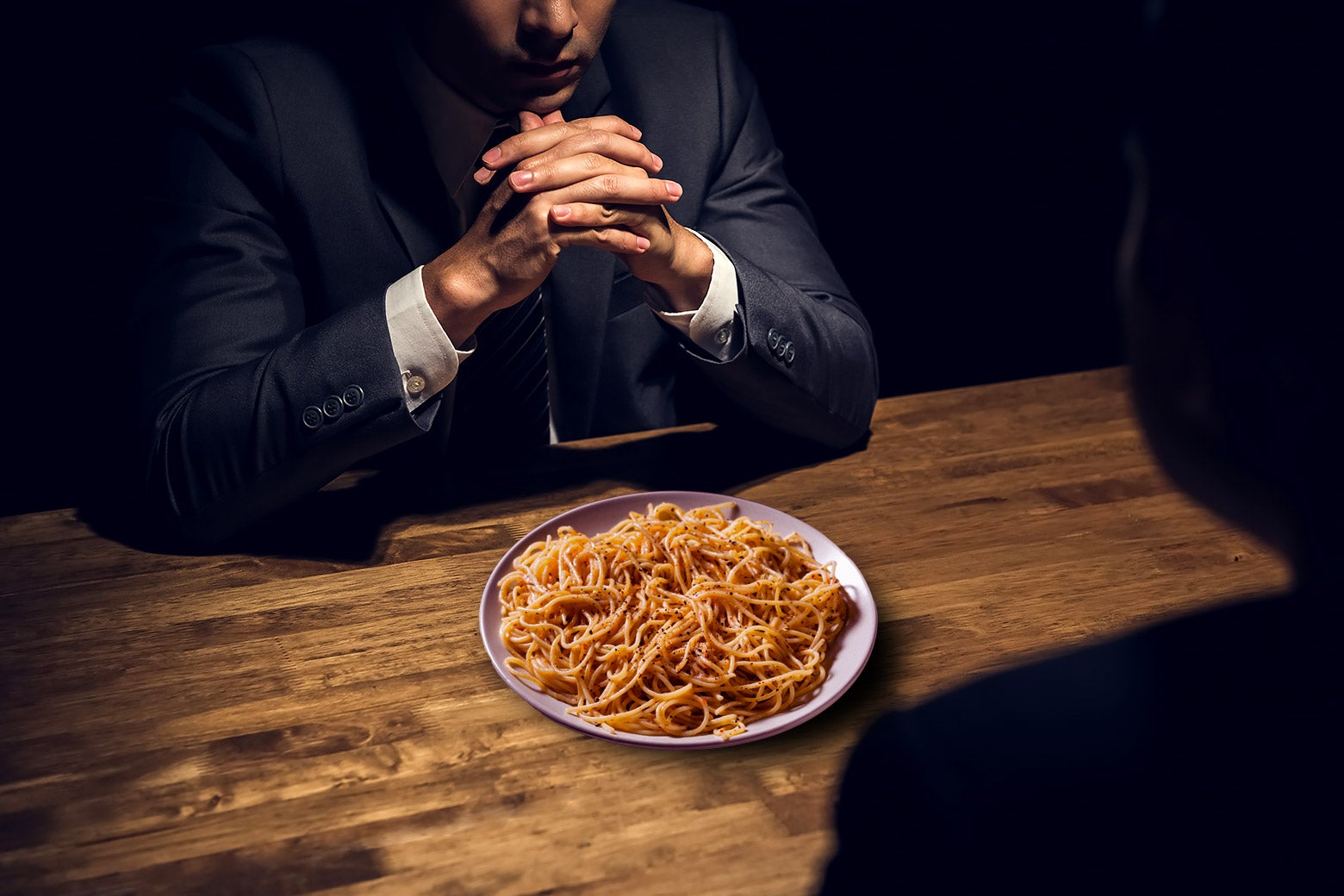Sign up for the Slatest to get the most insightful analysis, criticism, and advice out there, delivered to your inbox daily.
If you’ve ever been to a prestigious Italian restaurant, you’ve likely come across cacio e pepe. Literally meaning “cheese and pepper,” it’s a pasta dish that stands out on the menu, usually registering $5 to $10 cheaper than its noodly brethren due to its relative simplicity. But is cacio actually a good order at an Italian restaurant? After experiencing a series of dissatisfying, clumpy, overly ordinary busts of late, I’m starting to have my doubts.
Now, don’t get me wrong, cacio e pepe done right is wonderful. A true classic—luxurious, cheesy, silky, velvety, and compounded with robust flavor. A good cacio smacks you across the face with grassy heat and a coagulated richness; it’s a universally pleasing flavor, registering in our American brains like mac and cheese Italiano. And that’s why, after these recent flops, I can’t shake the feeling that something is amiss in restaurant kitchens.
You might say, Danny, surely if you’ve had one cacio e pepe, you’ve had them all! But I’m willing to bet that in the past few years, the ones you’ve tasted have been flat, boring, somehow … off. And I believe I know the source of this blight of dullness, a culprit that enjoys a vaunted reputation among chefs, but that has no place in this dish. I’m talking about butter.
In restaurant cooking, butter is a blunt object often used to beat you over the head, removing your logic and good sense in the process. A question I ask whenever I’m critiquing a restaurant: “Does this dish actually taste good? Or—does it taste like … butter?” And I’m telling you, most cacio e pepe I eat these days tastes like butter.
“Nine times out of 10 you’re going to get a butter-based cacio e pepe,” reveals chef Christian Stagliano, chef de cuisine at the Lonely Oyster in Los Angeles. Christian has been making and serving homemade pasta for years, and he’s worked in some of the finest Italian restaurants in Southern California. He knows that butter is an emulsion itself, a tasty thickener every chef uses to add both richness and texture. In short, it’s a weapon, and maybe one that’s become edgeless.
As Italians will tell you, true cacio e pepe doesn’t need butter. It is a delicate dance, a minimalist sauce requiring finesse and understanding. The pasta water needs to be starchier than usual to bind the ingredients, the pecorino Romano needs to be high-quality and grated finely. The creation of the sauce happens through alchemy and kinetic energy—a constant swirling and temperature regulation. The end result? Pure, simple, concentrated cheese-and-pepper flavor, and the antithesis of the buttery gut-bomb restaurants are all too happy to serve you. Call it pedantic, call it being a purist, but the latter strikes me as a different dish altogether.
In Italy, you won’t find much cacio e pepe made with butter, and there’s certainly no cream (some restaurants out here are using heavy cream!). Using unctuous dairy to create an Italian American fettuccine Alfredo is fine, but cacio e pepe is decidedly not that; if it were, the name of the dish wouldn’t include the main ingredients in their original language.
Many of the restaurants I’ve been referring to celebrate the four Roman pasta classics—carbonara, amatriciana, alla gricia, and cacio e pepe. These are pasta dishes that have been around for centuries, and in Italian cuisine, the details of these traditions matter. These traditions should be respected. If one is to carry the torch of authentic Italian food, as many restaurants claim to do, then they should also adhere to those practices to the letter.
Of course, there’s the other side of the argument—who cares? Let the people use the butter.
This Serious Eats recipe, developed by the wonderful Kenji López-Alt, prominently features butter, citing it as a way to help the cheese melt smoothly. Yet even he admits that too much butter can have a “dulling effect.” Most YouTube videos for cacio e pepe feature butter, too, and many chefs are caught using the ingredient. Anthony Bourdain’s favorite cacio e pepe, at a restaurant in Rome, no less, allegedly features lots of butter. Each of these wise people seem happy with the inclusion.
But what is lost when we distort a traditional Italian pasta dish? It’s possible that the answer is nothing. Many people are contented in their defilement. But, in the interest of experiencing true, excellent Italian cuisine, I would argue that perhaps cacio e pepe just isn’t meant to exist in restaurants. If it’s too finicky, so attention-focused that chefs have to use butter to stabilize the sauce for service, maybe it just shouldn’t be on the menu.
Speaking of menus, I would be remiss if I didn’t address the issue of the price. Though cacio e pepe is usually a relatively cheaper option, for a dish that only includes a few ingredients, I still do a double take whenever I see the cost.
At She Wolf in Detroit, luckily no pasta approaches $30, and their cacio e pepe is set at a safe $18. At Mother Wolf (no relation) in Los Angeles, another Roman-focused restaurant run by acclaimed American chef Evan Funke, cacio e pepe runs $25, with just about all other pastas running $30 or more. At Via Carota in New York City, $27. Now, I’m not saying it’s completely a rip-off—a night out is always money well spent in my opinion—but, to a home cook, this cost seems abnormally high; $30 for cheese and pepper? In this economy?
To prove the point, I made a version of cacio e pepe at home, with ingredients that I normally purchase:
½ pound De Cecco spaghetti, $1.24
1 teaspoon black pepper, 30 cents
3 ounces pecorino Romano, $2.36
Water, free
That’s a grand total of $3.90. Keep in mind that this is for half a pound of pasta—a much more generous portion than what you’ll receive at a restaurant.
For some reason, people will tell you that cacio e pepe is impossible to make at home and that you shouldn’t bother trying. But it’s really not all that hard. With quality ingredients, proportions, and technique, the dish comes together simply and swiftly. My tips: Use a shallow pan to cook your pasta for maximum starch in the pasta water. This water will emulsify and thicken your cheese sauce easily (no butter necessary). Second, mix the pecorino with a little pasta water in a separate bowl (almost like tempering an egg) before adding it to your cooked pasta, swirling everything gently on low heat. (For the full breakdown on how to make cacio e pepe properly, this video from Ethan Chlebowski is as comprehensive as it gets.)
Still, Stagliano maintains that cacio e pepe is a great order. “Order the cacio,” he says. “When it’s well made, it lives up to the hype.” Though he adds that he also hates too much butter. While I trust Stagliano to make a good one, I don’t have that same faith in everyone else. Too many restaurants are using the name cacio e pepe, but what they’re actually serving is pasta al burro—the Italian equivalent of fettuccine Alfredo.
Cacio e pepe is a fantastic flavor. What was once a well-guarded secret of Italy is now being infused into cheese puffs, bagels, and instant ramen. It’s a simple, wonderful taste that should be celebrated, and I’m glad it’s been getting the trend treatment. But I’m also worried that the OG dish is getting lost in the flavor’s wild popularity.
Like López-Alt says of the dish, “the best bites are the first two or three you take on the way to the table.” Maybe that’s how it should be enjoyed—at home, in a pan, probably alone. And hey, when you have as many hard-core opinions about pasta as I do, that’s usually how you’re eating it anyway.
















